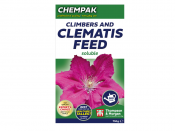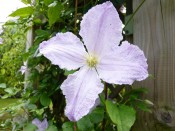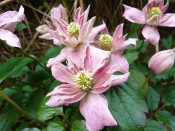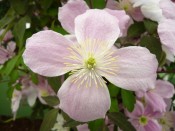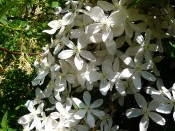'Elizabeth' is a vigorous very large deciduous climber with bronze young trifoliate leaves, mid green with age. Flowering with slightly scented pale pink flowers with pale yellow stamens from late spring to early summer with occasional later flowers. It is an early season clematis (Pruning Group 1) that flowers early in the year on shoots produced in the previous summer.
Pruning: Group 1 clematis do not need regular pruning but may be pruned if necessary after flowering in mid- to late spring. Trim overlong branches and prune back dead or winter-damaged shoots to a pair of healthy buds. Vigorous clematis, such as C. montana, can be simply sheared over after flowering to keep them tidy. Old congested plants can be renovated by cutting all stems back almost to the base, just after flowering. To restore the plants vigour apply Blood, Fish and Bone, mulch and water in dry spells. Wait at least three years before pruning hard again.
Cultural information: Clematis perform best in a deep, rich soil that remains moist but well-drained. They like their heads in the sun but the base of the plant should be kept cool and shaded by other plants. A layer of pebbles at the base will also be beneficial. Plant your new clematis with the crown 5–8cm (2–3in) deep to encourage new shoots to grow from below ground level and keep it well watered during its first Spring and Summer. Clematis are greedy feeders and benefit from regular feeding with Chempak Clematis Food.
Support: Clematis montana and its cultivars need to be well supported from the base upwards at all times as wind rock can cause the stems to break and wilt: they require a firm framework to grow on such as a sturdy trellis or large pergola using clematis plastic netting as additional support. Regularly tie in young shoots using a soft tie such as Flexi-tie.
Available for delivery in the following locations:
United Kingdom (England, Wales, Mainland Scotland, Scottish Islands, Scottish Highlands, Isle of Wight, Northern Ireland, Isles of Scilly)



